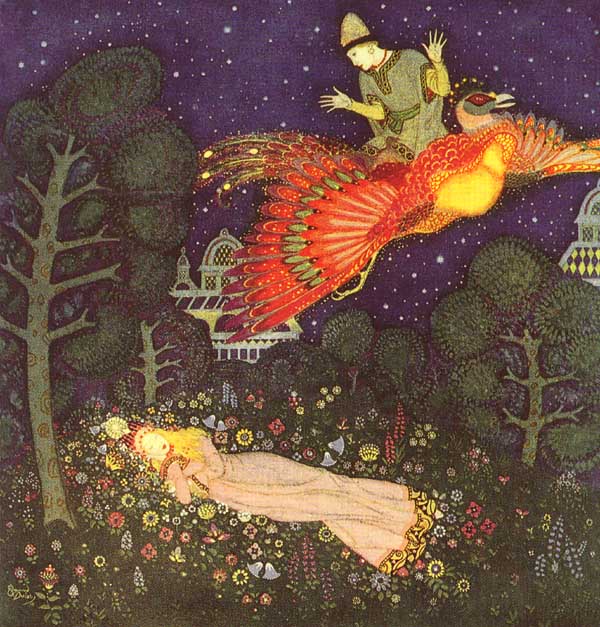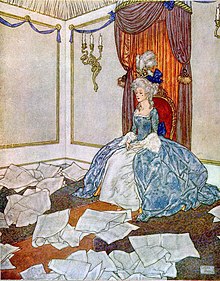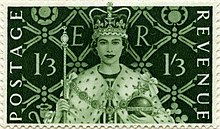Edmund Dulac
From Wikipedia, the free encyclopedia
Contents |
Early life and career
Born in Toulouse, France, he began his career by studying law at the University of Toulouse. He also studied art, switching to it full time after he became bored with law, and having won prizes at the Ecole des Beaux Arts. He spent a very brief period at the Académie Julian in Paris in 1904 before moving to London.[1]In London, the 22-year old Frenchman was commissioned by the publisher J.M. Dent to illustrate Jane Eyre.[1] He then began an association with the Leicester Gallery and Hodder & Stoughton; the gallery commissioned paintings from Dulac which they sold; the rights to the paintings were purchased by Hodder & Stoughton, who used them as illustrations in illustrated books, publishing one book a year. Books produced under this arrangement by Dulac include Stories from The Arabian Nights (1907) with 50 colour images; an edition of William Shakespeare's The Tempest (1908) with 40 colour illustrations; The Rubaiyat of Omar Khayyam (1909) with 20 colour images; The Sleeping Beauty and Other Fairy Tales (1910); Stories from Hans Christian Andersen (1911); The Bells and Other Poems by Edgar Allan Poe (1912) with 28 colour images and many monotone illustrations; and Princess Badoura (1913).
Dulac became a naturalized British Citizen on 17 February 1912.[2]
During World War I he contributed to relief books, including King Albert's Book (1914), Princess Mary's Gift Book, and, unusually, his own Edmund Dulac's Picture-Book for the French Red Cross (1915) including 20 colour images. Hodder and Stoughton also published The Dreamer of Dreams (1915) including 6 colour images - a work composed by the then Queen of Romania.
Later life
After the war, the not-deluxe edition illustrated book became a rarity and Dulac's career in this field was over. His last such books were Edmund Dulac's Fairy Book (1916), the Tanglewood Tales (1918) (including 14 colour images) and the The Kingdom of the Pearl (1920). His career continued in other areas however, including newspaper caricatures (especially at The Outlook), portraiture, theatre costume and set design, bookplates, chocolate boxes, medals, and various graphics (especially for The Mercury Theatre, Notting Hill Gate).He also produced illustrations for The American Weekly, a Sunday supplement belonging to the Hearst newspaper chain in America and Britain's Country Life. Country Life Limited (London) published Gods and Mortals in Love (1935) (including 9 colour images) based on a number of the contributions made by Dulac to Country Life previously. The Daughter of the Stars (1939) was a further publication to benefit from Dulac's artwork - due to constraints related to the outbreak of World War II, that title included just 2 colour images. He continued to produce books for the rest of his life, more so than any of his contemporaries, although these were less frequent and less lavish than during the Golden Age.
Halfway through his final book commission (Milton's Comus), Dulac died of a heart attack on 25 May 1953.
Stamp design
He designed postage stamps for Great Britain,[3] including the postage stamp issued to commemorate the Coronation of King George VI that was issued on 13 May 1937, The head of the King used on all the stamps of that reign was his design and he also designed the 2s 6d and 5s values for the 'arms series' high value definitives and contributed designs for the sets of stamps issued to commemorate the 1948 Summer Olympics and the Festival of Britain.[4]Dulac was one of the designers of the Wilding series stamps, which were the first definitive stamps of the reign of Queen Elizabeth II. He was responsible for the frame around the image of the Queen on the 1s, 1s 3d and 1s 6d values although his image of the Queen was rejected in favour of a photographic portrait by Dorothy Wilding to which he carried out some modifications by hand.[5] He also designed the 1s 3d value stamp of the set issued to commemorate the Coronation of Queen Elizabeth II[6] but he died just before it was issued.
Dulac designed stamps (Marianne de Londres series) and banknotes for Free France during World War II. In early 40s Edmund Dulac prepared also the project of Polish 20 zlotych note for the Bank of Poland (Bank Polski). This banknote (printed in England in 1942 but dated 1939) was ordered by Polish Government in Exile and was never issued.
See also
References
- ^ a b Edmund Dulac. Henry Ransom Humanities Research Center, University of Texas. Retrieved July 2, 2011.
- ^ Colin White Edmund Dulac, Studio Vista 1976 p.52
- ^ "George VI stamps". The British Postal Museum & Archive. Retrieved 2009-07-23.
- ^ David Aggersberg (1998). Great Britain Concise Stamp Catalogue. Stanley Gibbons Publications. ISBN 0-85259-443-7.
- ^ Royal Mail (2003). The Wilding Definitive Collection II. Royal Mail.
- ^ Bruns, Franklin R. (2006). The Stamps Of Elizabeth Regina And The Royal Family. Whitefish, Montana: Kessinger Publishing. p. 11. ISBN 1428661735.


































































































.jpg)


.jpg)

.jpg)

.jpg)
.jpg)
Post a Comment